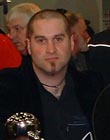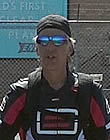|
|
This topic comprises 2 pages: 1 2
|
|
Author
|
Topic: CP65 random buzz sound
|
Bernie Anderson Jr
Master Film Handler
Posts: 435
From: Woodbridge, New Jersey
Registered: Apr 2000
|
 posted 12-23-2010 05:50 PM
posted 12-23-2010 05:50 PM





Hi guys,
I'm running a CP65 (with the Cat 300 cards installed) and a CE Reverse Scan ASR-30 reader in a RCA 9050.
I'm getting a weird random buzz that comes and goes and seems to happens when there is dialog or effect present in louder sequences. Its kind of hard to explain. Its not all the time. It seems to be present in all channels, particularly in the center. It almost sounds like a ground hum at some times and its comes and goes fairly quick with in a second. It isn't reading the sprockets of the film nor DTS time code.
I checked the A chain and slit loss, checked and re-seated all the optical cards.
On Digital (DTS), it sounds absolutely fine, only bad in analog. Switching inputs from Proj 1 to Proj 2 makes no difference, still present. I checked all connections. The Reverse scan is isolated from the projector and is "floating" and the Reverse scan is quiet when there is no film running through it, so its not a ground. Makes no difference if the 300 cards are in or not (It has the SR/A Cat 222 card too). It only seems to happen on high gain parts (almost like the cell input is too hot and is clipping, but its not).It's present in both A and SR but is worse in SR. Haven't tried it in mono yet. And it happens on different film stock.
Could it be my A-chain alignment? When the reader was in the theatre, I don't remember having this problem.
All I know is its in the A chain stage of the processor. Any suggestions?
Thanks
Bernie
| IP: Logged
|
|
|
|
|
|
|
|
|
|
|
|
|
|
|
|
|
|
|
|
|
|
|
|
Steve Guttag
We forgot the crackers Gromit!!!

Posts: 12814
From: Annapolis, MD
Registered: Dec 1999
|
 posted 12-24-2010 09:19 PM
posted 12-24-2010 09:19 PM




Cat 566, originally developed to allow one to precisely set up an exciter lamp, actually has proven to be one of the more useful tools when setting up a reverse scan reader.
The film has 6 tones recorded on it with 6 unique stripes. Thus, three tones are on the left channel and three tones are on the right. Each tone is one octave or so about the next. So, on an analyzer, you will six but three frequencies on each channel and if you sum the two channels, you will have six frequencies displayed. The lowest frequency plays on the left channel and it represents the left edge of the scanning area. The highest frequency is on the right channel and it represents the right edge of the scanning area.
So, when you look at the analyzer, you should see all six frequencies and the lowest and highest frequencies should be at approximately the same level and ideally all six frequencies are at the same level (presuming the film is recorded properly and you have 100% of the scanning area, you lens is even across its field...etc). The realities are, you will see the center two frequencies higher than the remaining four...depending on the lens, it will be more pronounced too.
With this film running, you can set the vertical (all frequencies get louder/softer) as well as the lateral position (outside frequencies get louder/softer). When you maximize all six frequencies, you have your LED optimized in its placement. Believe it or not, it can make a HUGE difference.
This film will let you see the flaw in those designs that do not allow for LED adjustment...particularly on Century soundheads...their machining tolerances varied GREATLY over the years...I have had to file or shim fixed LED mounts to get them to center on the film whilst keeping the lens centered on the cell. In my opinion, Component Engineering beat everyone on on this aspect as their LED mount can overcome poor machining by the soundhead manufacturer. Remember, most of these soundheads were only designed for optical mono. One did not have to be too good to get an mono cell to read the film. For reverse scan and digital, you really want to get things where they belong.
-Steve
| IP: Logged
|
|
|
|
Steve Guttag
We forgot the crackers Gromit!!!

Posts: 12814
From: Annapolis, MD
Registered: Dec 1999
|
 posted 12-25-2010 05:30 PM
posted 12-25-2010 05:30 PM




Buzz and Cat 566 are different tools. Buzz defines the width of the track. Buzz, which is camera original, is going to be more accurate than Cat. 566.
That said, they are interactive. If you don't have the LED positioned correctly, then you will not hear one of the tones (or not hear it as soon as you should). As such, one should alternate between the two until they both agree that the film is centered with respect to the LED (or vice-versa). Cat. 97 (alternating track) has little purpose in the reverse scanning reader other than to verify that the cell is centered with respect to the track (like it did with forward scan). The only reason it would be needed is if one had to accommodate a grossly shifted LED/Film. It can be run as a final check though. Once Cat 566 and Buzz agree that the LED and film are correct, run Cat 97...there should be ZERO cross talk and the two tones (one on each track) should be fully modulated and not clipped. Cat 97 can be quite useful for setting the analog magnification. Those theatres that run older prints that may have shrunk are advised to overscan a little bit. It is very rare that the optical track is actually modulated to 100% so overscanning to 102% or so will normally not bite you anymore than did did when it was being done on forward scanned with slit lenses and cells. The benefits are that one is less likely to pick up noise, the edge of the doped area, guard bands or even the DTS track. It is never advisable to underscan (show more than 100% of the track as the cell will see any of the junk out there)...so Cat 97 can be used to see if you are underscanning (push the film either way and the corresponding tone should start to clip. Buzz track (a more accurate test film) can also be used to check this too. If you are seeing both tones on the O'scope...you are under scanning. Cat 566, like Cat 97 will let you see if you are overscanning with Cat 97 being easier to interpret than Cat 566.
-Steve
| IP: Logged
|
|
|
|
All times are Central (GMT -6:00)
|
This topic comprises 2 pages: 1 2
|
Powered by Infopop Corporation
UBB.classicTM
6.3.1.2
The Film-Tech Forums are designed for various members related to the cinema industry to express their opinions, viewpoints and testimonials on various products, services and events based upon speculation, personal knowledge and factual information through use, therefore all views represented here allow no liability upon the publishers of this web site and the owners of said views assume no liability for any ill will resulting from these postings. The posts made here are for educational as well as entertainment purposes and as such anyone viewing this portion of the website must accept these views as statements of the author of that opinion
and agrees to release the authors from any and all liability.
|

 Home
Home
 Products
Products
 Store
Store
 Forum
Forum
 Warehouse
Warehouse
 Contact Us
Contact Us




 Printer-friendly view of this topic
Printer-friendly view of this topic
















